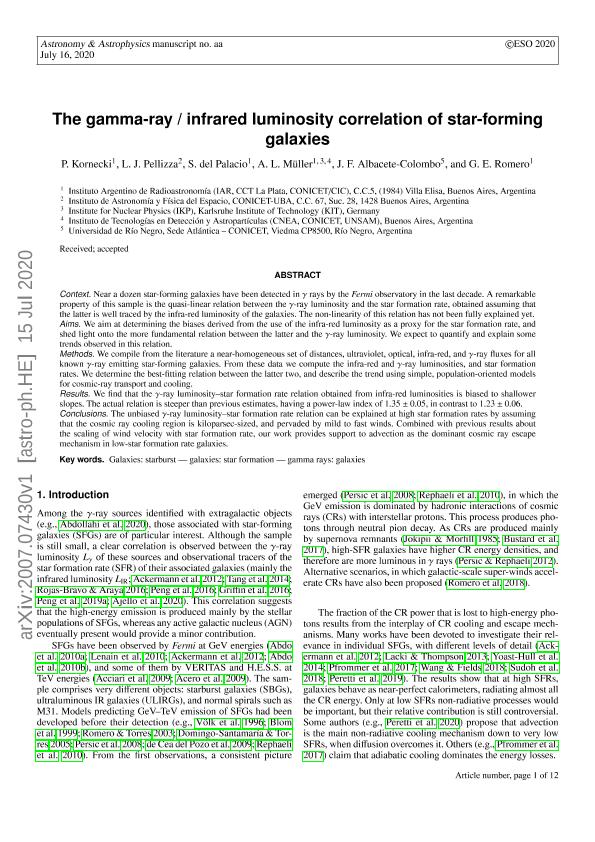Mostrar el registro sencillo del ítem
dc.contributor.author
Kornecki, Paula

dc.contributor.author
Pellizza González, Leonardo Javier

dc.contributor.author
del Palacio, Santiago

dc.contributor.author
Müller, Ana Laura

dc.contributor.author
Albacete Colombo, Juan Facundo

dc.contributor.author
Romero, Gustavo Esteban

dc.date.available
2020-12-30T15:35:54Z
dc.date.issued
2020-09
dc.identifier.citation
Kornecki, Paula; Pellizza González, Leonardo Javier; del Palacio, Santiago; Müller, Ana Laura; Albacete Colombo, Juan Facundo; et al.; γ-ray/infrared luminosity correlation of star-forming galaxies; EDP Sciences; Astronomy and Astrophysics; 641; 9-2020
dc.identifier.issn
0004-6361
dc.identifier.uri
http://hdl.handle.net/11336/121361
dc.description.abstract
Context. Nearly a dozen star-forming galaxies have been detected in γ-rays by the Fermi observatory in the last decade. A remarkable property of this sample is the quasi-linear relation between the γ-ray luminosity and the star formation rate, which was obtained assuming that the latter is well traced by the infrared luminosity of the galaxies. The non-linearity of this relation has not been fully explained yet. Aims. We aim to determine the biases derived from the use of the infrared luminosity as a proxy for the star formation rate and to shed light on the more fundamental relation between the latter and the γ-ray luminosity. We expect to quantify and explain some trends observed in this relation. Methods. We compiled a near-homogeneous set of distances, ultraviolet, optical, infrared, and γ-ray fluxes from the literature for all known γ-ray emitting, star-forming galaxies. From these data, we computed the infrared and γ-ray luminosities, and star formation rates. We determined the best-fitting relation between the latter two, and we describe the trend using simple, population-orientated models for cosmic-ray transport and cooling. Results. We find that the γ-ray luminosity-star formation rate relation obtained from infrared luminosities is biased to shallower slopes. The actual relation is steeper than previous estimates, having a power-law index of 1.35 ± 0.05, in contrast to 1.23 ± 0.06. Conclusions. The unbiased γ-ray luminosity-star formation rate relation can be explained at high star formation rates by assuming that the cosmic-ray cooling region is kiloparsec-sized and pervaded by mild to fast winds. Combined with previous results about the scaling of wind velocity with star formation rate, our work provides support to advection as the dominant cosmic-ray escape mechanism in galaxies with low star formation rates.
dc.format
application/pdf
dc.language.iso
eng
dc.publisher
EDP Sciences

dc.rights
info:eu-repo/semantics/openAccess
dc.rights.uri
https://creativecommons.org/licenses/by-nc-sa/2.5/ar/
dc.subject
GALAXIES: STAR FORMATION
dc.subject
GALAXIES: STARBURST
dc.subject
GAMMA RAYS: GALAXIES
dc.subject.classification
Astronomía

dc.subject.classification
Ciencias Físicas

dc.subject.classification
CIENCIAS NATURALES Y EXACTAS

dc.title
γ-ray/infrared luminosity correlation of star-forming galaxies
dc.type
info:eu-repo/semantics/article
dc.type
info:ar-repo/semantics/artículo
dc.type
info:eu-repo/semantics/publishedVersion
dc.date.updated
2020-12-04T18:36:52Z
dc.journal.volume
641
dc.journal.pais
Francia

dc.description.fil
Fil: Kornecki, Paula. Provincia de Buenos Aires. Gobernación. Comisión de Investigaciones Científicas. Instituto Argentino de Radioastronomía. Consejo Nacional de Investigaciones Científicas y Técnicas. Centro Científico Tecnológico Conicet - La Plata. Instituto Argentino de Radioastronomía; Argentina
dc.description.fil
Fil: Pellizza González, Leonardo Javier. Consejo Nacional de Investigaciones Científicas y Técnicas. Oficina de Coordinación Administrativa Ciudad Universitaria. Instituto de Astronomía y Física del Espacio. - Universidad de Buenos Aires. Facultad de Ciencias Exactas y Naturales. Instituto de Astronomía y Física del Espacio; Argentina
dc.description.fil
Fil: del Palacio, Santiago. Provincia de Buenos Aires. Gobernación. Comisión de Investigaciones Científicas. Instituto Argentino de Radioastronomía. Consejo Nacional de Investigaciones Científicas y Técnicas. Centro Científico Tecnológico Conicet - La Plata. Instituto Argentino de Radioastronomía; Argentina
dc.description.fil
Fil: Müller, Ana Laura. Provincia de Buenos Aires. Gobernación. Comisión de Investigaciones Científicas. Instituto Argentino de Radioastronomía. Consejo Nacional de Investigaciones Científicas y Técnicas. Centro Científico Tecnológico Conicet - La Plata. Instituto Argentino de Radioastronomía; Argentina
dc.description.fil
Fil: Albacete Colombo, Juan Facundo. Karlsruhe Institute Of Technology; Alemania
dc.description.fil
Fil: Romero, Gustavo Esteban. Universidad Nacional de San Martín; Argentina. Provincia de Buenos Aires. Gobernación. Comisión de Investigaciones Científicas. Instituto Argentino de Radioastronomía. Consejo Nacional de Investigaciones Científicas y Técnicas. Centro Científico Tecnológico Conicet - La Plata. Instituto Argentino de Radioastronomía; Argentina
dc.journal.title
Astronomy and Astrophysics

dc.relation.alternativeid
info:eu-repo/semantics/altIdentifier/url/https://www.aanda.org/10.1051/0004-6361/202038428
dc.relation.alternativeid
info:eu-repo/semantics/altIdentifier/doi/https://doi.org/10.1051/0004-6361/202038428
Archivos asociados
